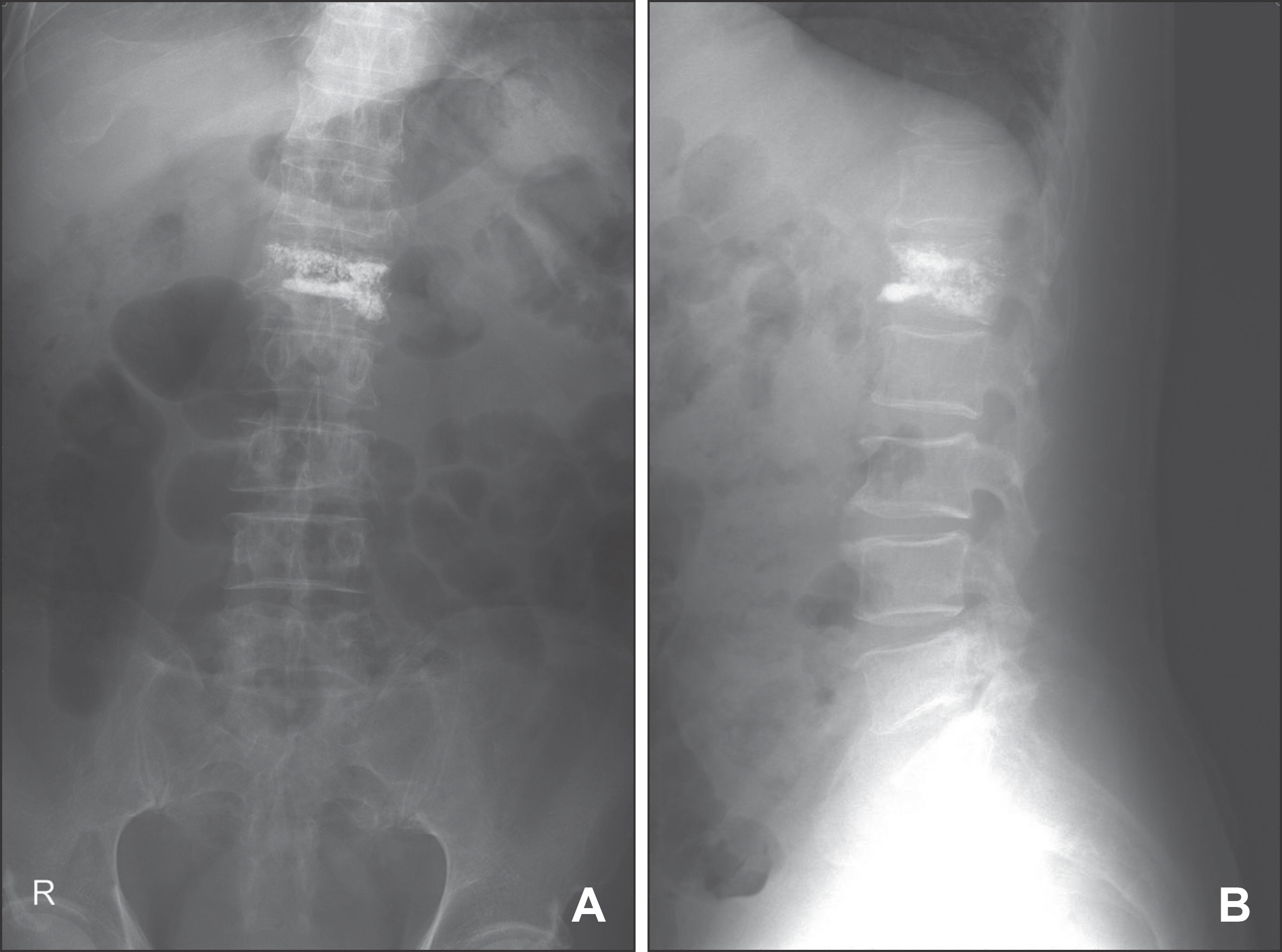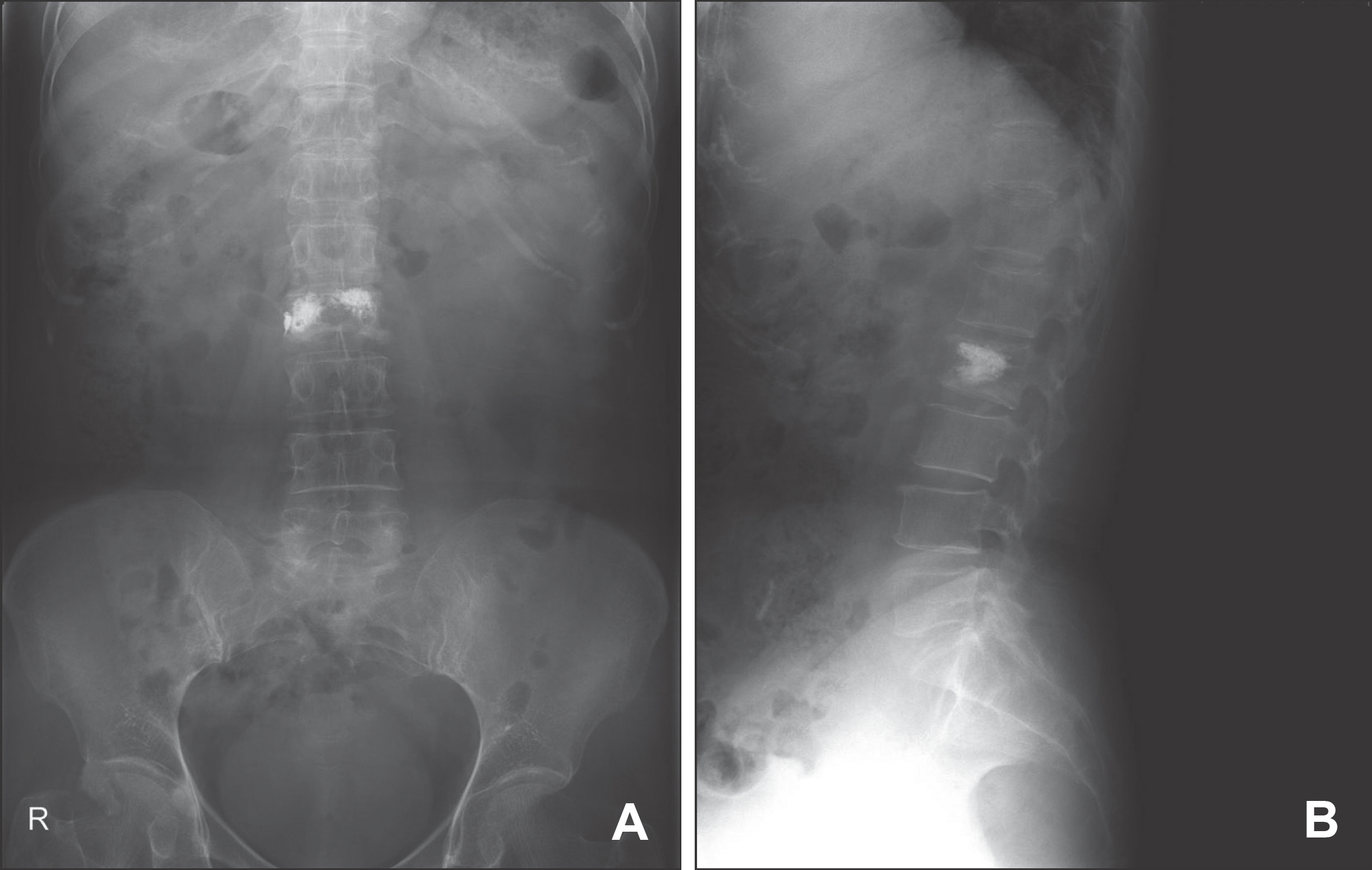Korean J Neurotrauma.
2013 Oct;9(2):120-124. 10.13004/kjnt.2013.9.2.120.
Risk Factors for Subsequent Fracture after Osteoporotic Vertebral Compression Fracture
- Affiliations
-
- 1Department of Neurosurgery, VHS Medical Center, Seoul, Korea. euro3399@naver.com
- KMID: 2156112
- DOI: http://doi.org/10.13004/kjnt.2013.9.2.120
Abstract
OBJECTIVE
Percutaneous vertebroplasty is an effective treatment that relieves pain caused by vertebral compression fracture. However, vertebroplasty may increase the risk for subsequent vertebral compression fracture. The purpose of this study is to evaluate the incidence of and risk factors for subsequent fracture after vertebroplasty.
METHODS
A retrospective analysis was performed for 112 patients who were diagnosed with a first osteoporotic compression fracture at a single level and underwent vertebroplasty at that level. Possible risk factors for subsequent fracture, such as age, sex, bone mineral density (BMD), location of treated vertebrae, pattern of cement distribution, cement volume, presence of intradiscal cement leakage, and direction of cement leakage, were analyzed.
RESULTS
During the follow-up period, 18 new subsequent vertebral fractures developed (16.1%). Subsequent fractures were more common in osteoporotic patients (T-score < or =-2.5)(p=0.034, r=0.208). Intravertebral cement volume > or =3.5 cc were also associated with a significantly higher risk of fracture (p=0.012, r=0.238).
CONCLUSION
Low BMD and volume of intravertebral cement were the factors most strongly associated with subsequent fracture after percutaneous vertebroplasty.
MeSH Terms
Figure
Cited by 1 articles
-
Gradual Height Decrease of Augmented Vertebrae after Vertebroplasty at the Thoracolumbar Junction
Han San Oh, Tae Wan Kim, Hyun Gon Kim, Kwan Ho Park
Korean J Neurotrauma. 2016;12(1):18-21. doi: 10.13004/kjnt.2016.12.1.18.
Reference
-
References
1. Ahn Y, Lee JH, Lee HY, Lee SH, Keem SH. Predictive factors for subsequent vertebral fracture after percutaneous vertebroplasty. J Neurosurg Spine. 9:129–136. 2008.
Article2. Al-Ali F, Barrow T, Luke K. Vertebroplasty: what is important and what is not. AJNR Am J Neuroradiol. 30:1835–1839. 2009.3. Lee KA, Hong SJ, Lee S, Cha IH, Kim BH, Kang EY. Analysis of adjacent fracture after percutaneous vertebroplasty: does intradiscal cement leakage really increase the risk of adjacent vertebral fracture? Skeletal Radiol. 40:1537–1542. 2011.
Article4. Liebschner MA, Rosenberg WS, Keaveny TM. Effects of bone cement volume and distribution on vertebral stiffness after vertebroplasty. Spine (Phila Pa 1976). 26:1547–1554. 2001.
Article5. Lin WC, Lee YC, Lee CH, Kuo YL, Cheng YF, Lui CC, et al. Refractures in cemented vertebrae after percutaneous vertebroplasty: a retrospective analysis. Eur Spine J. 17:592–599. 2008.
Article6. Liu WG, He SC, Deng G, Guo JH, Fang W, Zhu GY, et al. Risk factors for new vertebral fractures after percutaneous vertebroplasty in patients with osteoporosis: a prospective study. J Vasc Interv Radiol. 23:1143–1149. 2012.
Article7. Lo YP, Chen WJ, Chen LH, Lai PL. New vertebral fracture after vertebroplasty. J Trauma. 65:1439–1445. 2008.
Article8. Luo J, Daines L, Charalambous A, Adams MA, Annesley-Williams DJ, Dolan P. Vertebroplasty: only small cement volumes are required to normalize stress distributions on the vertebral bodies. Spine (Phila Pa 1976). 34:2865–2873. 2009.9. Molloy S, Mathis JM, Belkoff SM. The effect of vertebral body percentage fill on mechanical behavior during percutaneous vertebroplasty. Spine (Phila Pa 1976). 28:1549–1554. 2003.
Article10. Mudano AS, Bian J, Cope JU, Curtis JR, Gross TP, Allison JJ, et al. Vertebroplasty and kyphoplasty are associated with an increased risk of secondary vertebral compression fractures: a population-based cohort study. Osteoporos Int. 20:819–826. 2009.
Article11. Nam JR, Park SB, Ha SI. Subsequent vertebral fracture after percutaneous vertebral augmentation: adjacent and non-adjacent vertebral fractures. Korean J Spine. 6:17–21. 2009.12. Nieuwenhuijse MJ, Putter H, van Erkel AR, Dijkstra PD. New vertebral fractures after percutaneous vertebroplasty for painful osteoporotic vertebral compression fractures: a clustered analysis and the relevance of intradiskal cement leakage. Radiology. 266:862–870. 2013.
Article13. Rho YJ, Choe WJ, Chun YI. Risk factors predicting the new symptomatic vertebral compression fractures after percutaneous vertebroplasty or kyphoplasty. Eur Spine J. 21:905–911. 2012.
Article14. Steens J, Verdonschot N, Aalsma AM, Hosman AJ. The influence of endplate-to-endplate cement augmentation on vertebral strength and stiffness in vertebroplasty. Spine (Phila Pa 1976). 32:E419–E422. 2007.
Article15. Syed MI, Patel NA, Jan S, Harron MS, Morar K, Shaikh A. New symptomatic vertebral compression fractures within a year following vertebroplasty in osteoporotic women. AJNR Am J Neuroradiol. 26:1601–1604. 2005.16. Trout AT, Kallmes DF. Does vertebroplasty cause incident vertebral fractures? A review of available data. AJNR Am J Neuroradiol. 27:1397–1403. 2006.17. Trout AT, Kallmes DF, Kaufmann TJ. New fractures after vertebroplasty: adjacent fractures occur significantly sooner. AJNR Am J Neuroradiol. 27:217–223. 2006.18. Ye HH, Cha JH, Cho CW, Kim YS, Kim DJ. The incidence of recurrent vertebral fracture after kyphoplasty or vertebroplasty. J Korean Neurotraumatol Soc. 4:84–88. 2008.
Article19. Yokoyama K, Kawanishi M, Yamada M, Tanaka H, Ito Y, Hirano M, et al. Safety and therapeutic efficacy of the second treatment for new fractures developed after initial vertebroplasty performed for painful vertebral compression fractures. Neurol Res. 35:608–613. 2013.
Article20. Yoo CM, Park KB, Hwang SH, Kang DH, Jung JM, Park IS. The analysis of patterns and risk factors of newly developed vertebral compression fractures after percutaneous vertebroplasty. J Korean Neurosurg Soc. 52:339–345. 2012.
Article21. Zhang Z, Fan J, Ding Q, Wu M, Yin G. Risk factors for new osteoporotic vertebral compression fractures after vertebroplasty: a systematic review and metaanalysis. J Spinal Disord Tech. 26:E150–E157. 2013.
- Full Text Links
- Actions
-
Cited
- CITED
-
- Close
- Share
- Similar articles
-
- Intraspinal Extradural Cyst Subsequent to a Vertebral Compression Fracture - A Case Report -
- Risk Factors for Subsequent Vertebral Compression Fracture Following Osteoporotic Compression Fracture
- Subsequent Vertebral Fracture after Percutaneous Vertebral Augmentation: Adjacent and Non-adjacent Vertebral Fractures
- Cement Leakage into Disc after Kyphoplasty: Does It Increases the Risk of New Adjacent Vertebral Fractures?
- Early Onset Subsequent Vertebral Compression Fracture after Percutaneous Verteroplasty



